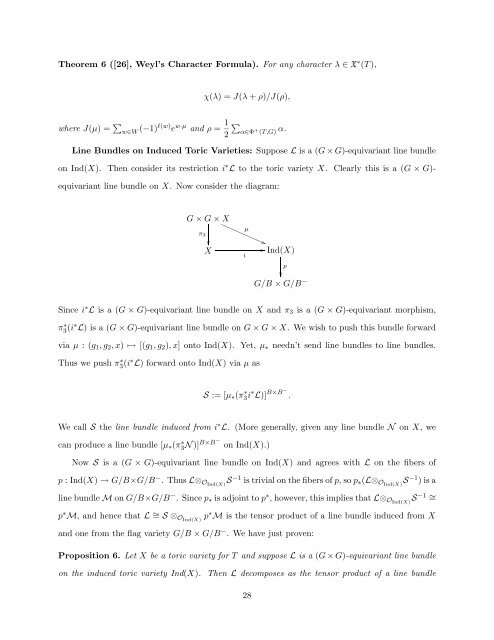Equivariant Embeddings of Algebraic Groups
Equivariant Embeddings of Algebraic Groups
Equivariant Embeddings of Algebraic Groups
Create successful ePaper yourself
Turn your PDF publications into a flip-book with our unique Google optimized e-Paper software.
Theorem 6 ([26], Weyl’s Character Formula). For any character λ ∈ X ∗ (T ),<br />
χ(λ) = J(λ + ρ)/J(ρ),<br />
where J(µ) = ∑ w∈W (−1)l(w) e w·µ and ρ = 1 2<br />
∑<br />
α∈Φ + (T,G) α.<br />
Line Bundles on Induced Toric Varieties: Suppose L is a (G × G)-equivariant line bundle<br />
on Ind(X). Then consider its restriction i ∗ L to the toric variety X. Clearly this is a (G × G)-<br />
equivariant line bundle on X. Now consider the diagram:<br />
G × G × X<br />
µ<br />
<br />
π 3<br />
<br />
X<br />
i<br />
Ind(X)<br />
p<br />
<br />
G/B × G/B −<br />
Since i ∗ L is a (G × G)-equivariant line bundle on X and π 3 is a (G × G)-equivariant morphism,<br />
π3 ∗(i∗ L) is a (G × G)-equivariant line bundle on G × G × X. We wish to push this bundle forward<br />
via µ : (g 1 , g 2 , x) ↦→ [(g 1 , g 2 ), x] onto Ind(X). Yet, µ ∗ needn’t send line bundles to line bundles.<br />
Thus we push π3 ∗(i∗ L) forward onto Ind(X) via µ as<br />
S := [µ ∗ (π ∗ 3i ∗ L)] B×B− .<br />
We call S the line bundle induced from i ∗ L. (More generally, given any line bundle N on X, we<br />
can produce a line bundle [µ ∗ (π ∗ 3 N )]B×B−<br />
on Ind(X).)<br />
Now S is a (G × G)-equivariant line bundle on Ind(X) and agrees with L on the fibers <strong>of</strong><br />
p : Ind(X) → G/B×G/B − . Thus L⊗ OInd(X) S −1 is trivial on the fibers <strong>of</strong> p, so p ∗ (L⊗ OInd(X) S −1 ) is a<br />
line bundle M on G/B×G/B − . Since p ∗ is adjoint to p ∗ , however, this implies that L⊗ OInd(X) S −1 ∼ =<br />
p ∗ M, and hence that L ∼ = S ⊗ OInd(X) p ∗ M is the tensor product <strong>of</strong> a line bundle induced from X<br />
and one from the flag variety G/B × G/B − . We have just proven:<br />
Proposition 6. Let X be a toric variety for T and suppose L is a (G × G)-equivariant line bundle<br />
on the induced toric variety Ind(X). Then L decomposes as the tensor product <strong>of</strong> a line bundle<br />
28
















